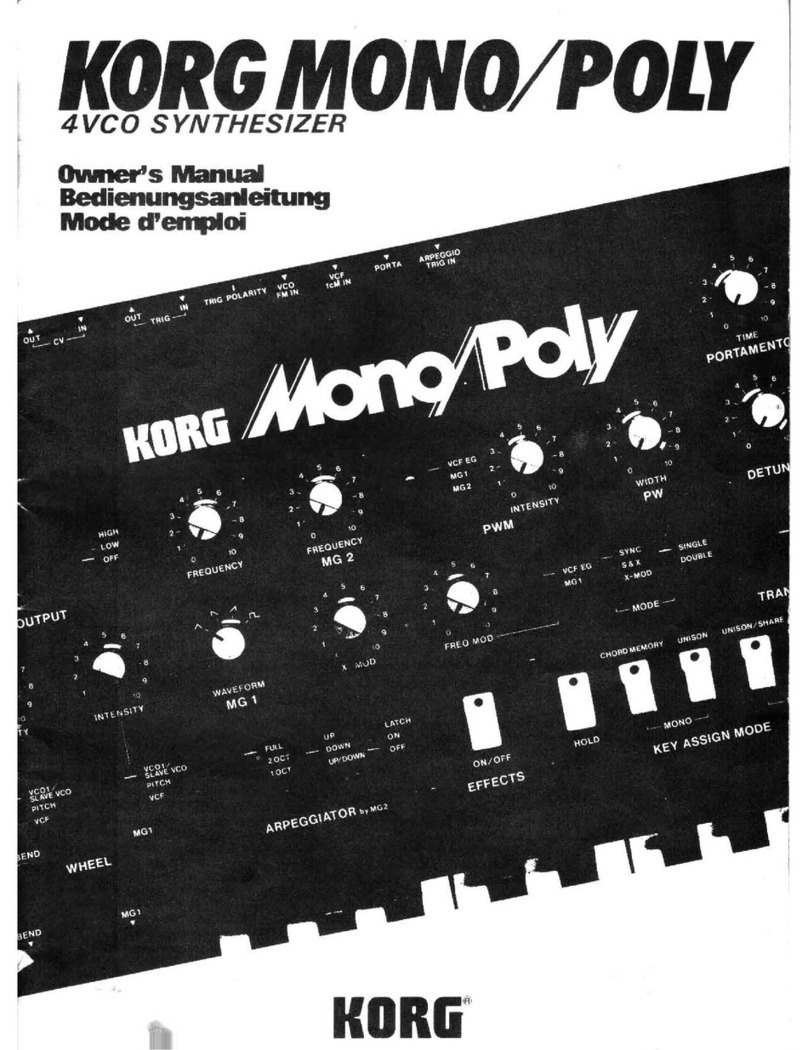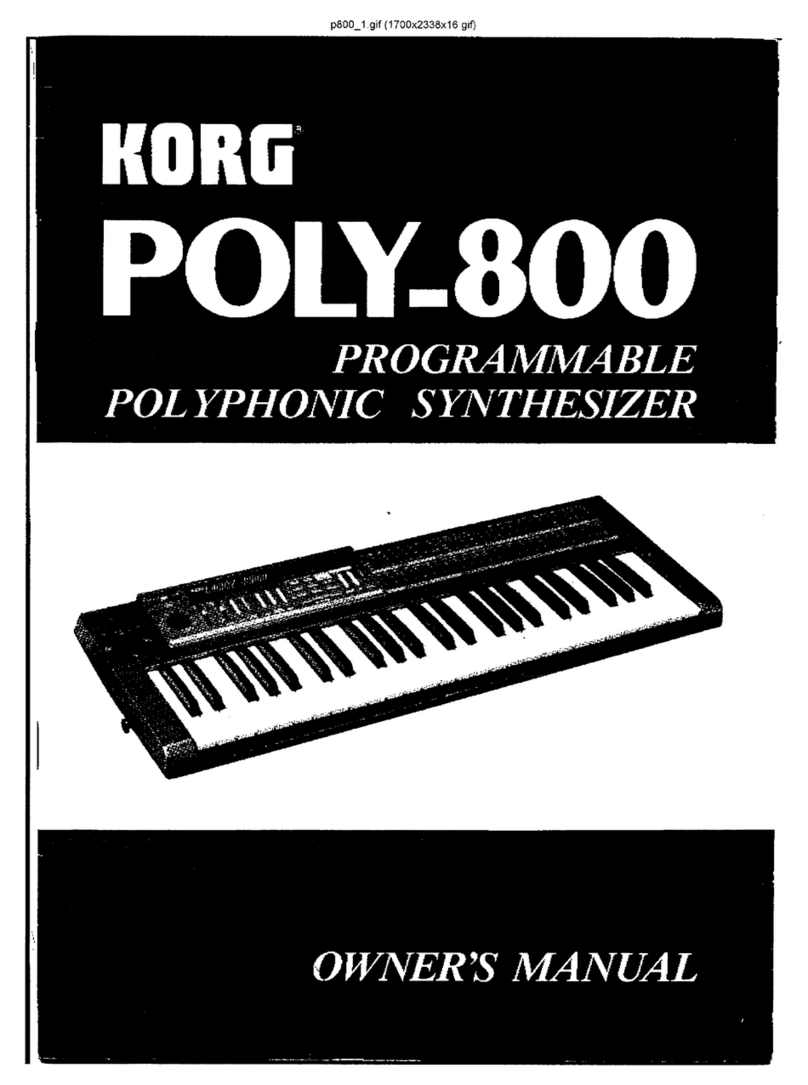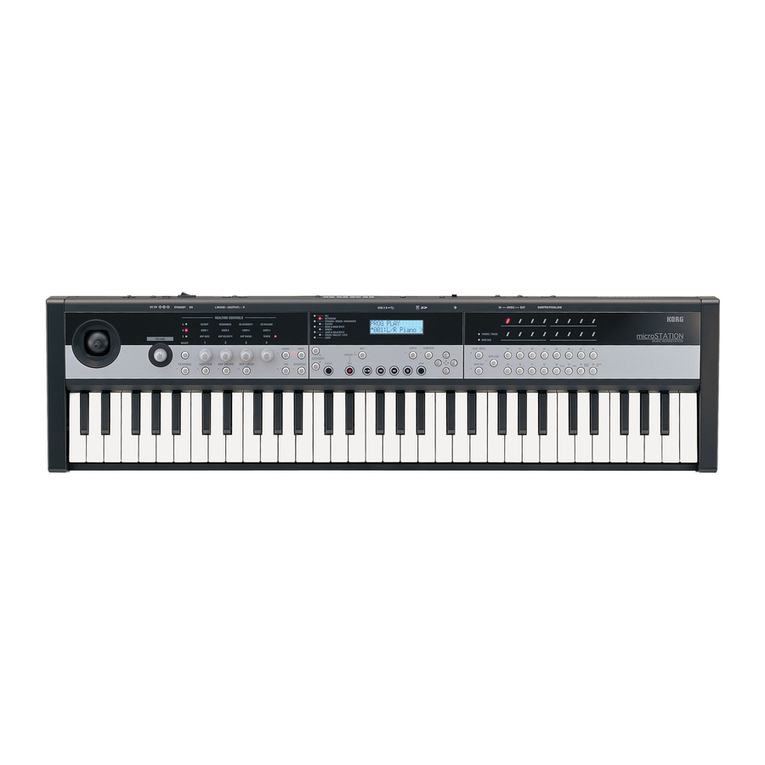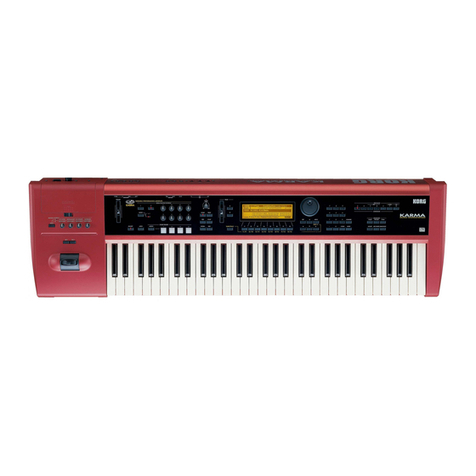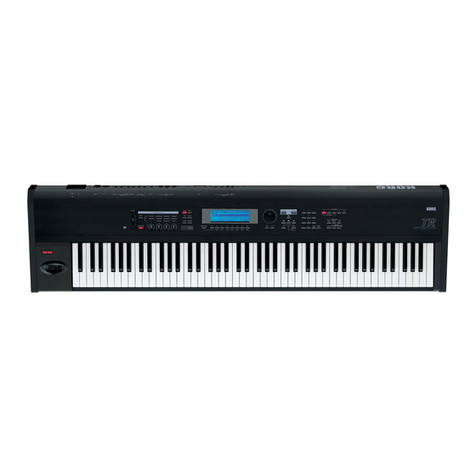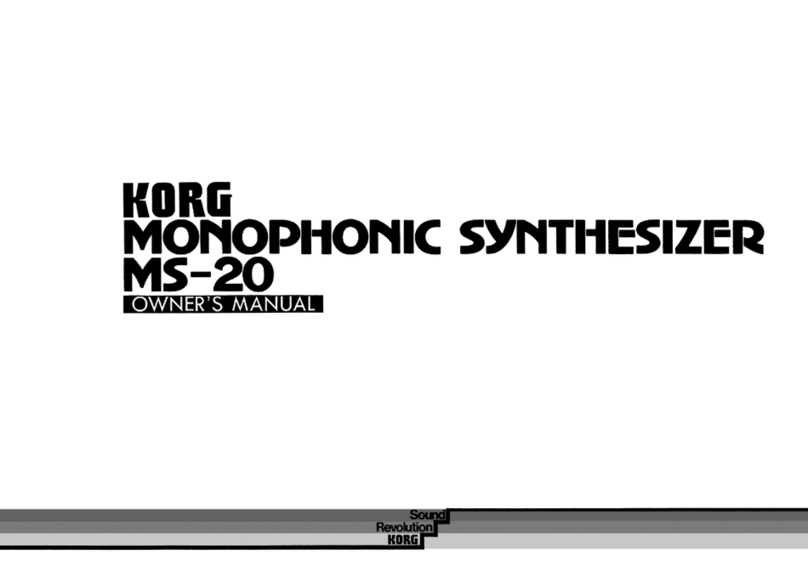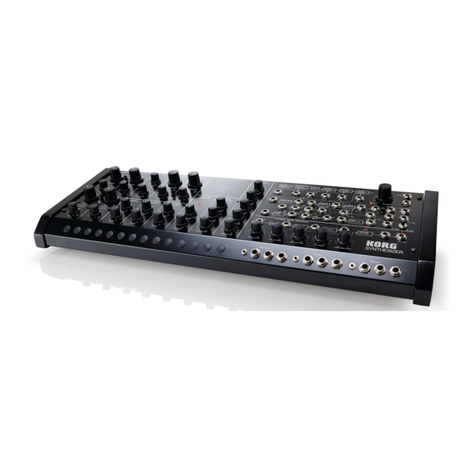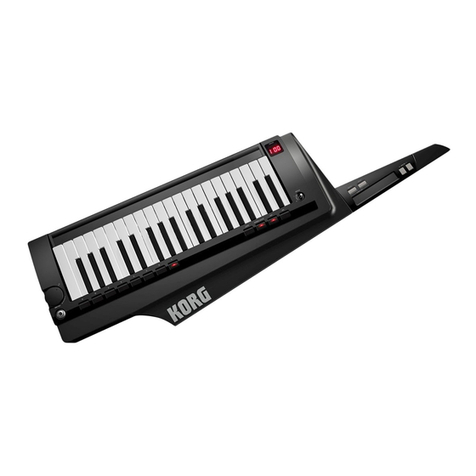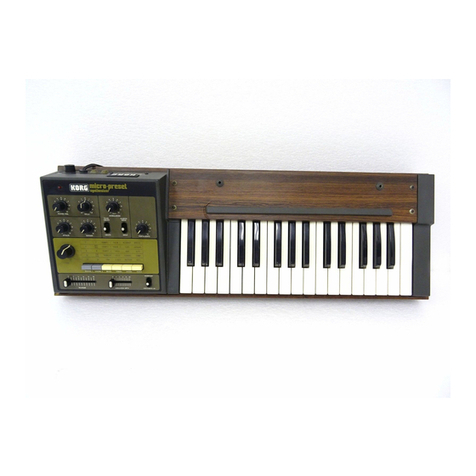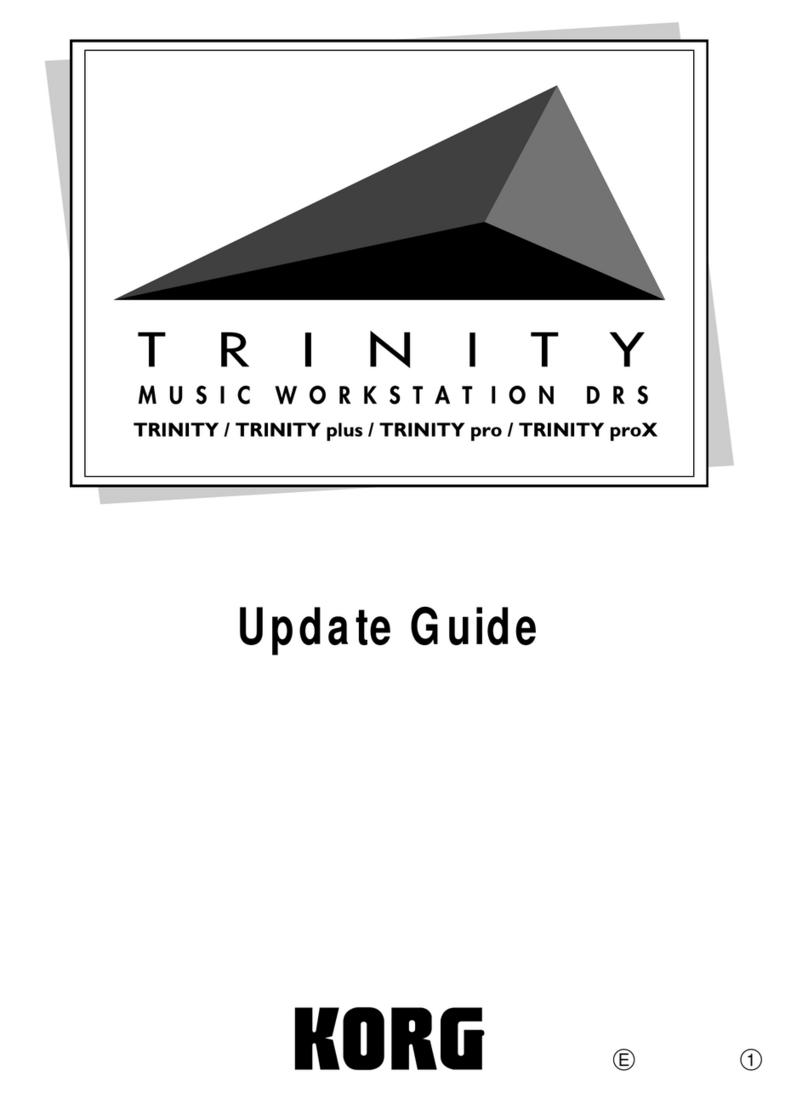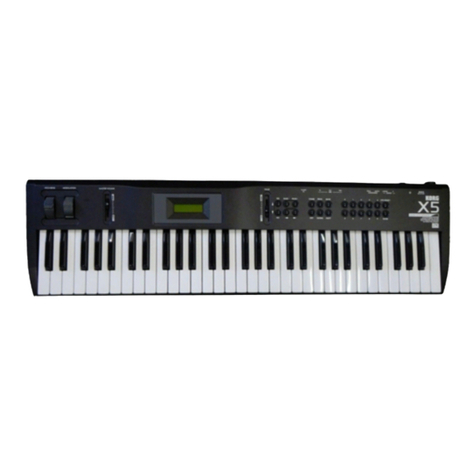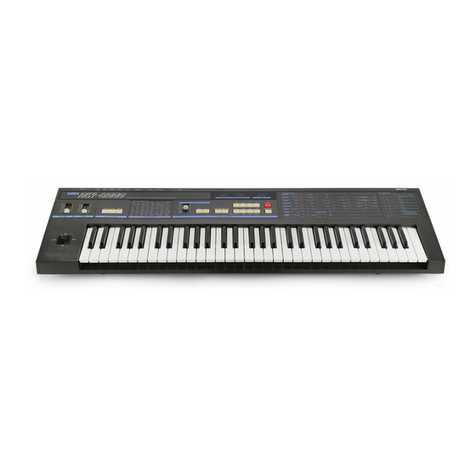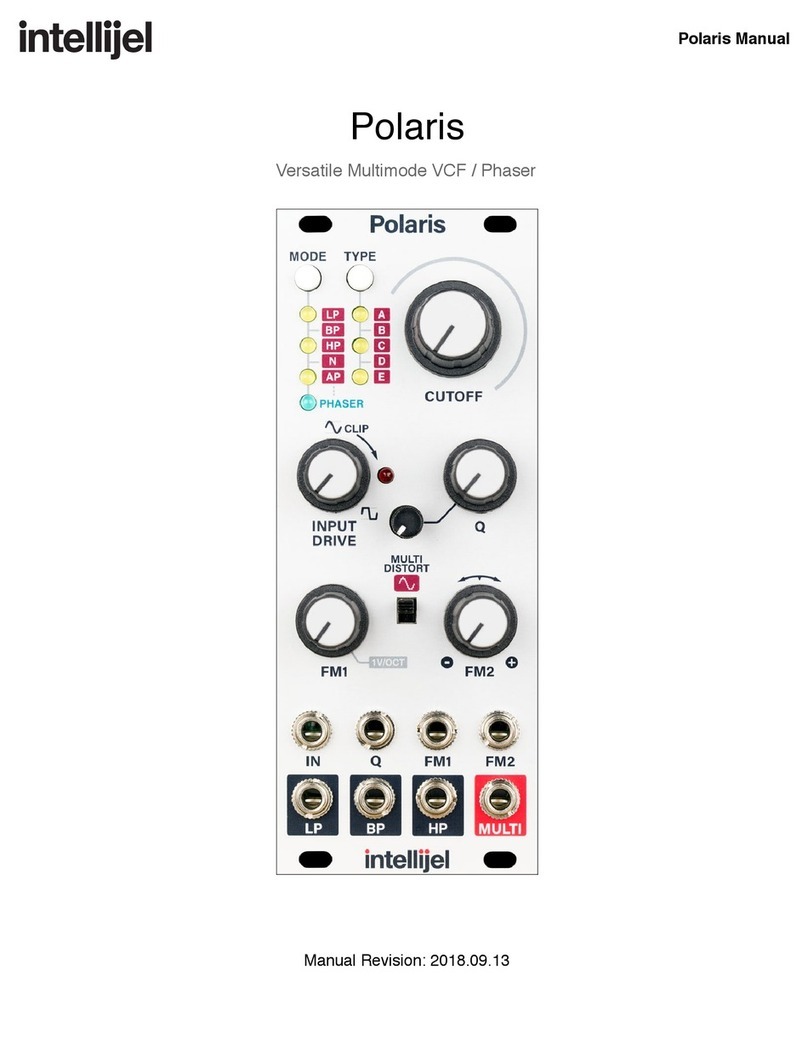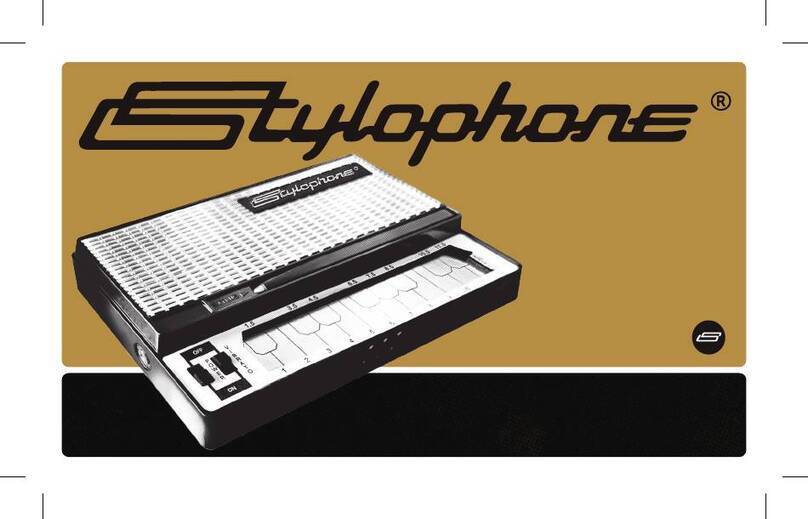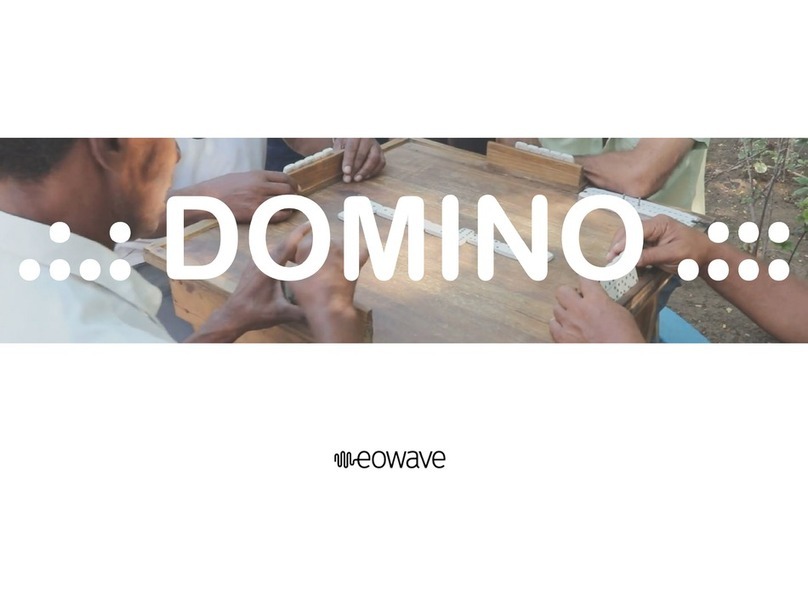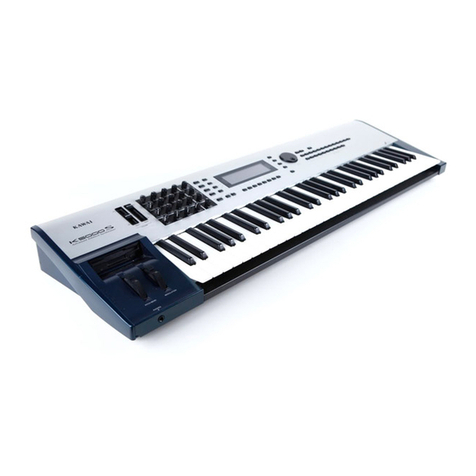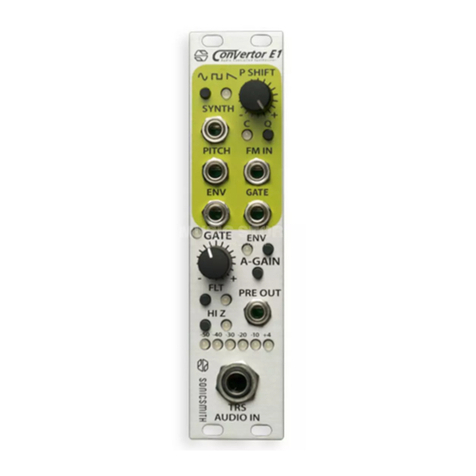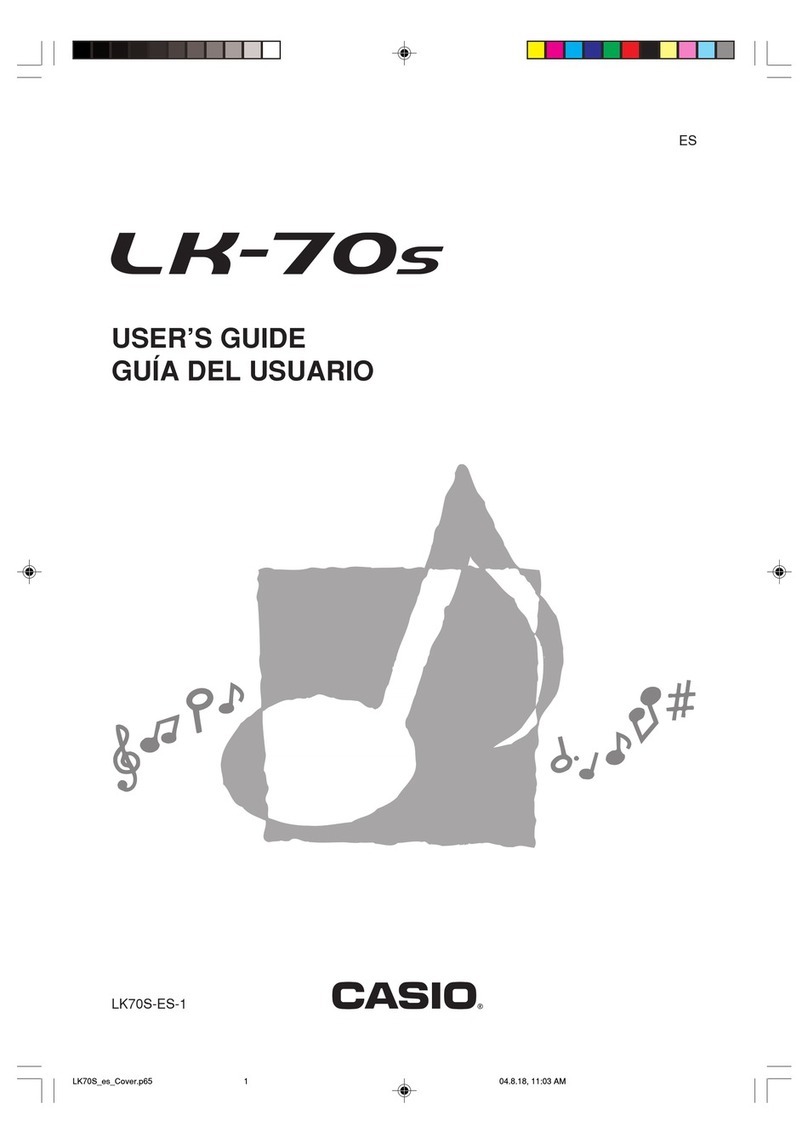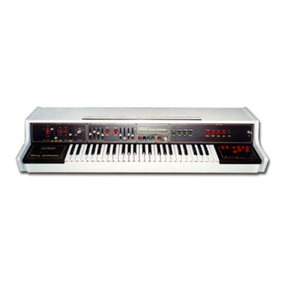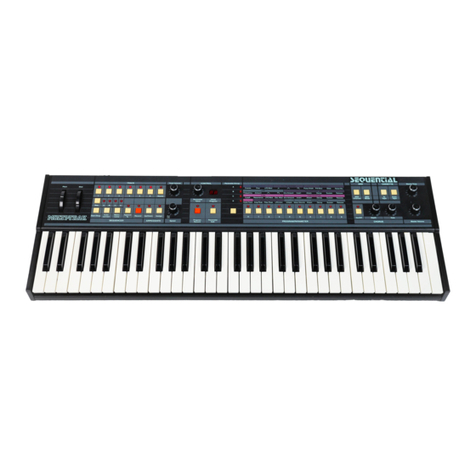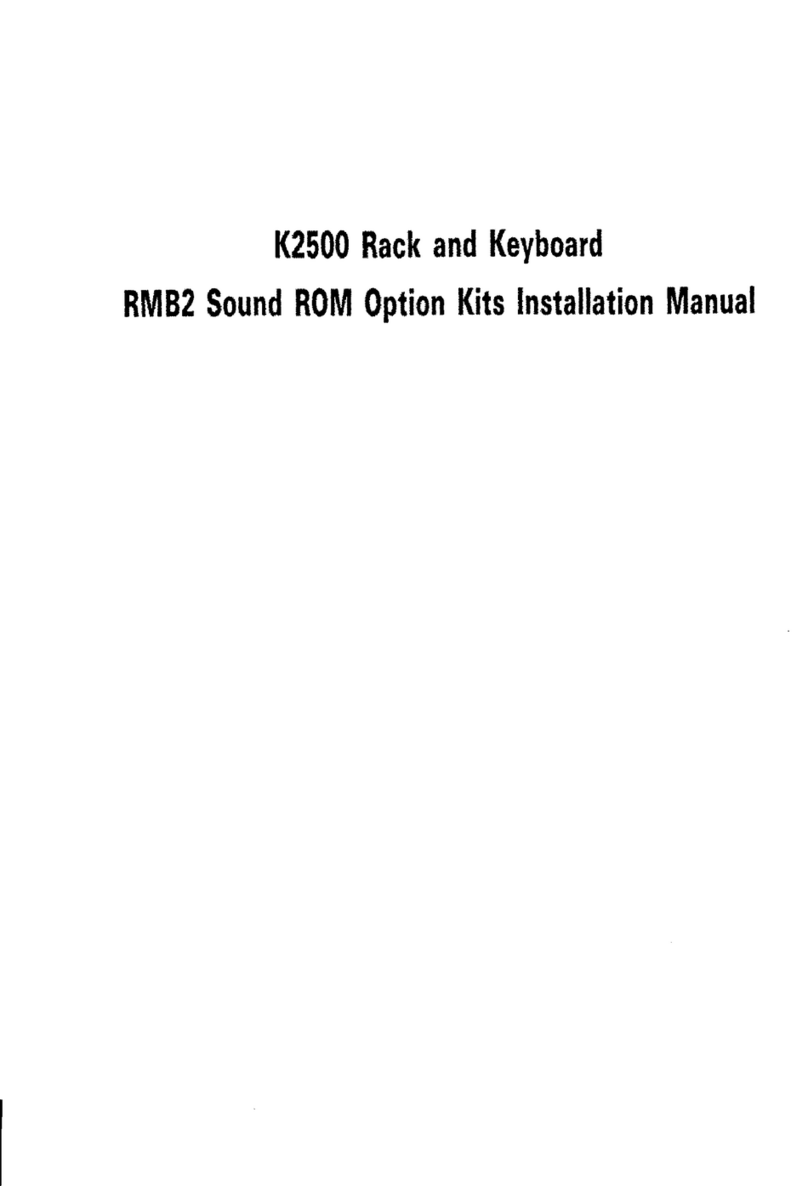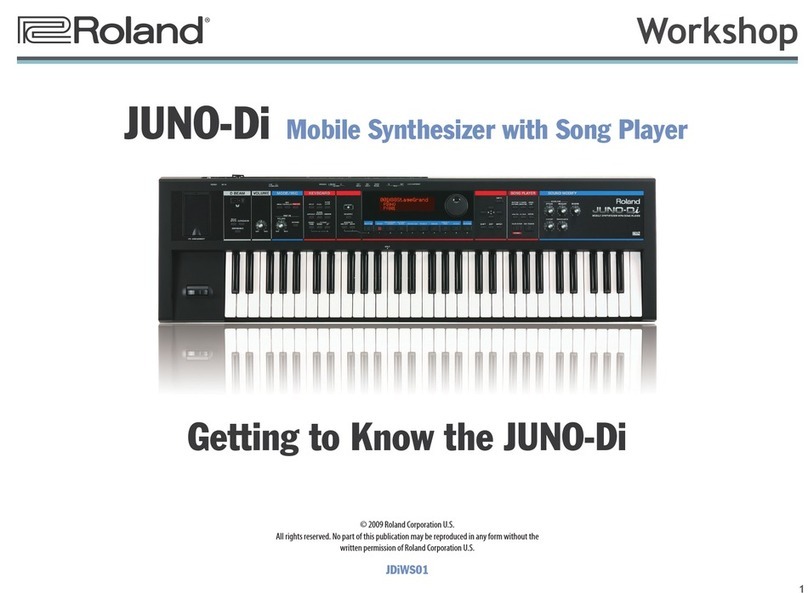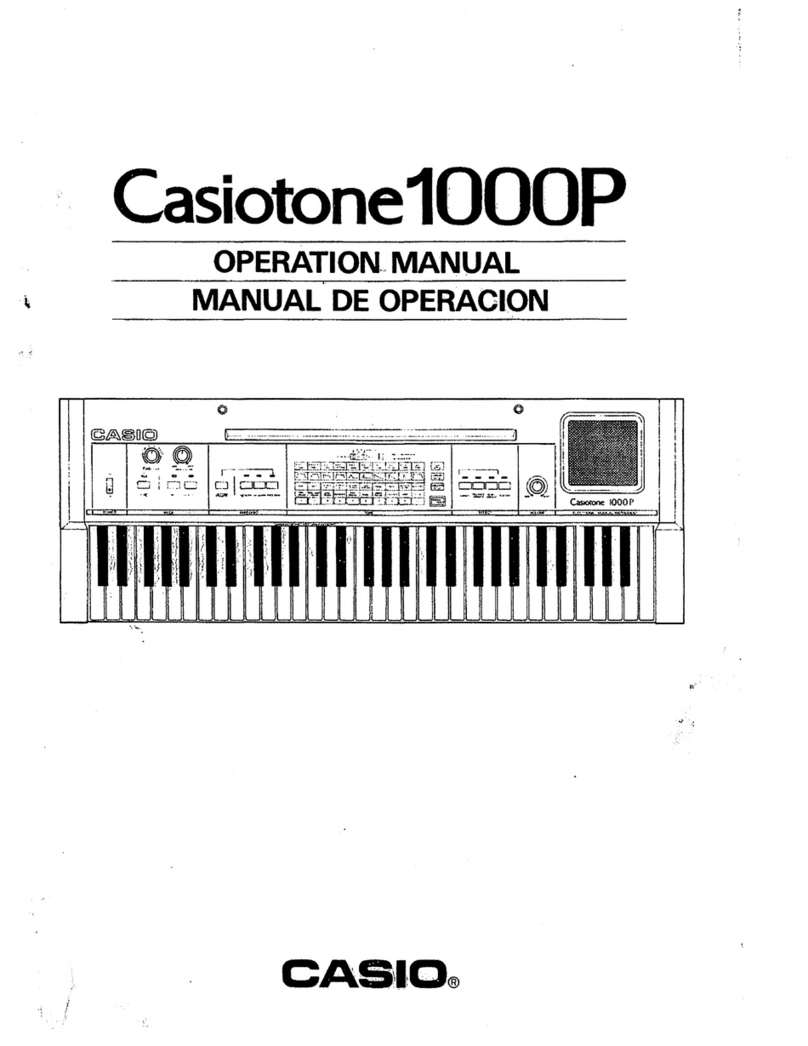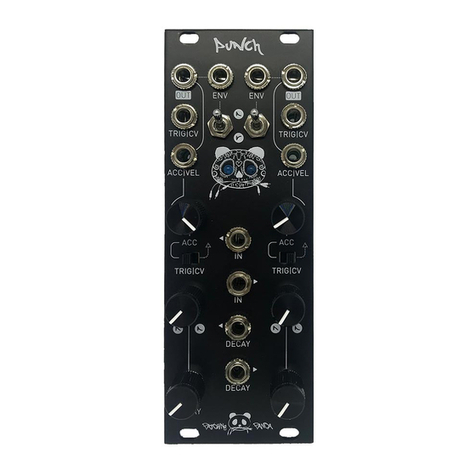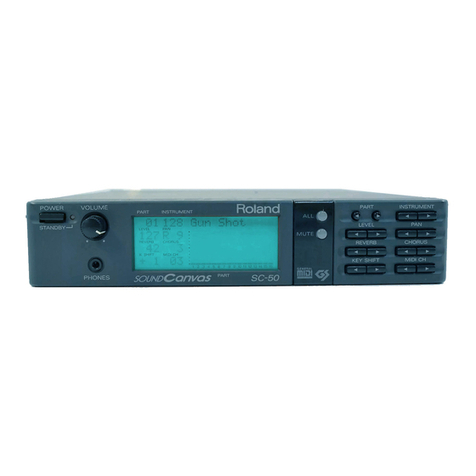Korg Kronos Analogic User manual

- Sound Research & Development -
Kronos Analogic by kpr
Intuitive synthesizer handling concept for K RG KR N S Music Workstation. With smart
and easy-to-use multi-Controller assignment that simulates typical analog synthesizer
panels. Plus additional tablet-style version via convenient TouchDisplay.
Introduction
An analog synthesizer usually provides a lot of knobs and buttons, that makes it easy to
tweak the sounds. The Kronos Analogic exactly does this and turns the Kronos into an
analog synthesizer. Therefore all Controller knobs, the both Joysticks, the Ribbon,
Sliders, buttons are assigned to act like typical analog synthesizer do. No matter which
internal sound engine is used for a Program Preset: You can always handle it totally
intuitive by using this slick standard system.
It is a convenient performance feature to make your playing more impressive and
dynamic, and also a sound design option to make own Program Presets simply by using
the Analogic system. You don’t need to step through the display menus, everything can
be done with Controllers and the cool Tone Adjustment Control Surface via TouchView
Display.
You don’t have to “learn” synthesizer handling or read and study hundreds of manual
pages. Everything you need to know is described in short sentences below.
Have fun playing successfully the Kronos Analogic!

Handling Guide
You might play the sounds in the first place, to find out how they work for you. This is
also the moment where you can try out the Kronos Analogic Controller assignment. You
will notice, that it follows a specially developed setting. This means that even if you don’t
have own experiences with analog synthesizer you will easily find the typical synthesizer
sound shaping functions like Filter, Envelopes, etc. and they are always located on the
same Knobs, Buttons, etc. on the Kronos.
Check out all their functions with learning by doing. You can handle the sound shaping on
the Controller field on the left with one hand while playing the synth in the Kronos with
the other hand and it feels like doings this on a real analog synthesizer with knobs.
Kronos Analogic Controller Assignment Details
The Kronos Controller section on the left from the display is the center for Synth
Performer. In total there are 8 knobs, 2 buttons, 2 different Joysticks and a Touch
Ribbon.

As additional overview function the display shows a full Controller set with their amount
and mode settings when pushing the Control Surface tab on the lower right in the
display.
Real Time Knobs
Knobs are the most typical real time modifiers on analog synthesizers. You can find the
Kronos Real Time Knobs on the panel’s upper left next to the Main Volume Knob.
To simulate the original feeling the entire Knobs Section for Kronos Analogic is assigned
with all the sound modifier functions we know well from the analog synthesizers: Filter
Cutoff and Resonance as well as Attack, Decay, Sustain and Release Time and more. Find
details about the knobs below.

The Default position of the Knobs is always in the center. If you don’t want to catch the
programmed amount with a Knob movement from any current position you can set all
Knobs to the center before playing a Program Preset.
The Kronos Panel print directly above the Knobs 5-8 is “User 1-4”, but as the Kronos
Analogic assignments are fixed as convenient standard setting for all Program Presets
with the functions Attack Time, Decay Time, Sustain Level and Effect Control, the below
picture shows how the Panel print for all Kronos Analogic Program Presets actually should
look.
Knob 1: Filter Cutoff
Knob 2: Filter Resonance
Knob 3: EG Intensity
Knob : EG Release Time
Knob 5: Attack Time
Knob 6: Decay Time
Knob 7: Sustain Level
Knob 8: Effect Control
Here are the other Kronos real time controller and they all are programmed with sound
shaping functions and performance controls.
Joystick 1: Tone Blend
SW1: Octave down
SW2: Ribbon lock
Joystick 2: Bend up/down X, Vibrato/Modulation Y
Ribbon: Brillance, Cutoff
Aftertouch: Vibrato
Velocity: Loudness/Contour

Knob 1 Filter Cutoff
This is the most used analog synth tone modifier. Turn the Knob to the right for a high
value to get a rich sound that provides many high frequencies.
Turning the Knob to the left will reduce the amount of high frequencies and the tone will
be soft and a dull. Using this effect during playing perfomance is typical for many music
styles and is very interesting too for Arpeggios. The Filter Cutoff works in combination
with the next Knob 2.
Knob 2 Filter Resonance
Another typical analog synthesizer tone shaping function. With Filter Resonance you can
make the sound sharper and it depends on the Filter Cutoff setting how the tone will be
altered.
Turning the Knob to the right will enhance this effect and settings within the highest
range zone can create kind of self-oscillation effects.
Knob 3 EG Intensity
With this Knob you can easily control the entire amount of the Envelope Generator
settings.
Turning the knob to the left will make the sound duration or a part of it’s progress in time
shorter, to the right will extend the effect during that time.

Knob Release Time
Actually this knob should be placed on another position, after Sustain Level to be specific.
But as there is a printed EG Release above the knob, I decided to keep it where it is.
This function determines how long the sound will fade away after let off a key. Turning
the knob to the right it might be infinite like a hold effect, turning to the left will shorten
the Release time.
Knob 5 Attack Time
The tone attack is one of the most important sound shaping function, so the knob is right
here on position 5. n the Kronos Analogic Panel photo the Knob 5 name print is Attack
Time.
Hitting a key when the knob is turned to the left will provide an instant sound, but when
you turn it to the right the sound will take a while until full volume.
Knob 6 Decay Time
With Decay Time you can determin how quick a sound will fade away after hitting a key.
n the Kronos you will find this function on Knob 6. n the Kronos AnalogicPanel photo
(for details see Appendix) the Knob 6 name print is Decay Time.
Turn the knob to the left for a very short sound and to the right to make it longer.

Knob 7 Sustain Level
This is the main volume function for a sound. With Sustain you can control the volume of
the sound’s hold phase. Sustain Level is assigned to Knob 7 on the second last position in
the Real Time Knob row. n the Kronos AnalogicPanel photo (for details see Appendix)
the Knob 7 name print is Sustain Level.
Turning the knob to the right will make this Sustain volume loud and turning to the right
will reduce the volume level.
Knob 8 Effect Control
Although the most analog synthesizers don’t have built-in effect devices like Reverb,
Delay, etc. the Kronos does. And it is a very handy function to control those effects with
a dedicated knob. Here you will find this effects control on Knob 8. n the Kronos
AnalogicPanel photo (for details see Appendix) the Knob 8 name print is Effect Control.
Usually the effect setting and intensity of the Kronos Analogic presets are convenient and
suitable for many music production situations and on stage, but sometimes less is more
or you might want even more effects intensity or add a second one.
Exactly this can be done with this knob. It depends on the individual preset how it will
shape the sound. Sometimes it will reduce the Reverb intensity when turning the knob to
the left, other sounds might allow to add another effect like Chorus or Flanger to enhance
the sound.

Joystick 1
The unlabeled Joystick on the upper left works as sound mixer, so for Kronos Analogic I
called it
Tone Blend Control
You can alter the sound mix of a Preset by turning the Joystick in all directions and from
one point to the next in any speed. Using this function can help to get more real time
modification effects into your sounds.
Joystick 2
The Joystick below located on the left above the Ribbon is a classic synthesizer tool and
can be used to bend tones and get Vibrato effects to a sound while playing the
performance.
The Joystick offers four general positions left, right, forward, backward and they are
working as described here:

Right: Bend up
Pull the Joystick to the right for a tone bend up effect like a guitar player is doing it,
usually it’s setted to 2 semi-tones. Some pads with slow attack time might have a full
octave setting though.
Left: Bend down
Pull the Joystick to the left for the same tone bend effect, but this time the bending
works downward.
Forward: Vibrato
Pulling the Joystick forward will deliver a Vibrato effect. The most effective Vibrato dose
can be reached at the maximum position.
Backward: Tone Modulation
Pulling the Joystick backward a tone modulation will change the timbre of the selected
sound. The effect is different from one to another preset, it depends on the individual
sound how it will act and you will find the dynamically controllable effects Tremolo, Filter
Cutoff, Harmonic Structure, etc.

SW Buttons
Those buttons are located above the just mentioned Joystick and are per-setted with
typical synthesizer functions.
Their LED will lit when the assigned function is active, so you will always have the visible
control about the current setting. n the Kronos Analogicsoundbank the default position
usually is ff. Push the button to turn the function on.
SW1 Octave down
The SW1 Button delivers an instant ctave down shift and acts like a typical Key
Transpose function with a fixed amount.
SW2 Ribbon Position fix
As the below described Ribbon’s typical assignment is Filter Cutoff it is handy to get the
chance to fix a Cutoff amount at any Ribbon position. Push the SW2 Button while holding
the Ribbon’s position with the other finger and the current position will be fixed until you
push the SW2 Button once again. The SW2 LED will lit when the function is in mode n.

Ribbon Tone Brillance Control
The Ribbon is located on the Kronos panel lower left. Use it with the fingertip and move it
in both directions while still holding the finger on the Ribbon. The preset’s default setting
is the Ribbon’s middle position, sliding to the right will usually ad more brillance to the
sound while the sound will be duller the more you slide the finger to the left.
Some presets have other assignments though, check the documentation for details.
Aftertouch
Pushing a key while holding it will affect a Vibrato effect. Although Vibrato is already
assigned to the above mentioned Joystick, but it can be quite handy when it can be done
with the keyboard though, especially when you need both hands for playing your
performance.
Also you can bend a tone with the Joystick and simultaneously add a Vibrato with the
keyboard, a convenient solution when playing solo parts.

Velocity
The provided presets Velocity allows a dynamic performance and it depends on the
individual sound how it works: Volume, Tone Brillance, Wha attack effects, etc. Please
see the documentation for further details.
Drum Track
All presets have a dedicated Drum Track programming. Just push the DRUM TRACK
Button to start the concerned beat of a preset. The presets default position is ff.
The carefully selected assignment of rhythms is different from one preset to the next and
always fits to the individual sound in a way. All tempo, drum and percussion kit, volume,
etc. settings are suitable to the sound and also aligned to the below described KARMA
functions.
KARMA: Arpeggios and Patterns
All presets have a dedicated KARMA programming. Just push the KARMA n/ ff Button
to active the function. The Button’s LED will lit then. The presets default position is ff.
Programmed KARMA patterns can be controlled with the eight real time control Sliders on
the Kronos panel above the lower keyboard part.
Push the RT KN BS/KARMA Button left from the Sliders to make them active and push
the KARMA GE Tab in the display to view the programmed settings and watch changes
when moving the Sliders.

As KARMA is far more than just a typical synthesizer Arpeggiator a special user panel is
accessable to handle all the different KARMA parts. The interaction of all KARMA parts
allows many of variations and can be used in real time too.
Although KARMA is synced to the DRUM TRACK (LED lits when active) it’s necessary to
study the individual KARMA settings to understand how it works and to find out what
different playing techniques are suitable for it and it can be used in many different ways
as well.
Check the KARMA settings of the below listed presets with all there described details to
get a basic KARMA knowledge for perfect use of them when playing the sounds of the
Kronos Analogicsoundbank.
You will find the eight KARMA functions on the display’s second last line lowly, and when
you push this KARMA GE folder button the programmed values can be viewed and altered
at any time for many different variations.
The values are mentioned in the Sliders field and when you move one of the eight
Controller Sliders the related amount will change. For this function the RT/KN BS KARMA
Button on the left from the Sliders must be pushed, the Button’s LED will lit in active
mode.
Each Preset can keep up to seven additional so called KARMA Scenes for those variations.
Here is the list of them and a description what you can do with them.
Force Mono: Amount of Swing feeling. A 000 setting provides a straight rhythm and the
more you move the Slider 1 forward to the middle position the Swing feeling will be
hearable. Moving the Slider 1 to maximum position will strongly quantize the notes.
Note Scale Type: Type of the rhythm. This controls note repeat speed, beat position
and note structure.
Invert Phrase: Duration Control, sets of the notes.
Note Pattern <> Random: Accent position, velocity control,
Bend On/Off: Note range
Bend Direction: Bend start.
Repeat Rhythm Value: Repeat repetitions.
Repeat Volume/Decay: Repeat transpose.

All KARMA functions should be checked with the below example Presets. Play around with
all sliders and play on the keyboard. You will quite quickly find out how everything works,
and that they interact with each other too.
The silders are not really a real time tool for on stage, however perhaps the Scene
Buttons anyway, but eventually for studio recording purposes for sure. KARMA is indeed
a nice and welcome inspiration source for song writing.
The KARMA settings of all Presets are ready-to-use, the sound shaping can be done
easily with all Controllers on the fly, no sound programming or further KARMA knowledge
necessary. Just use it!
TouchView Display Synthesizer
There is one more spectacular Kronos Analogic feature: The unique TouchView Display
Synthesizer! This allows to control the Kronos synthesizer sounds via display. The
handling is nearly self-explaining, and again the provided parameter set and assignment
is done with a conceptual standard, that works the same (or very similar) for every
Program Preset. No matter which internal sound engine is used for a specific Program
Preset.

The above screenshot shows the AL-1 sound engine view. Just push the Control Surface
submenu button in the display, plus the T NE ADJ. button. The assigned parameter
arrangement is similar to any analog synthesizer. Now you can use all the shown Kronos
Controllers to tweak the sounds, and it also works with the data entry section.
All other synthesizer engines settings are arranged along to their parameters and are a
bit different to the AL-1 standard setting, but still “analogish” in a way.
By pushing the RT/KARMA button in the display the Controller arrangement instantly
turns back to the previous “raw” parameter arrangement.
The TouchDisplay Synthesizer is worth to explore on it’s own.

Here is an example for the Analogic standard Controller assignment:
Preset 070 Syn Clav
Preset Number Program Name
Knob 1 Knob 2 Knob 3 Knob Knob 5 Knob 6 Knob 7 Knob 8
Filter
Cutoff
Filter
Resonance
EG
Intensity
Release
Time
Attack
Time
Decay Time Sustain
Level
Effect
Intensity/Additional
Effect
Joystick
1
SW1 SW2 Joystick 2
X
Joystick 2
Y
Ribbon Aftertouch Velocity
Tone
Blend
ctave
down
Ribbon
fix/lock
right up
left down
+2/-2
up: Vibrato
down:
Modulation
Brillance,
Cutoff
Vibrato Loudness
Blank chart for your own puposes, you can print it out and use it for your sounds and
then save it for later references.
Preset Number Program Name
Knob 1 Knob 2 Knob 3 Knob Knob 5 Knob 6 Knob 7 Knob 8
Joystick
1
SW1 SW2 Joystick 2
X
Joystick 2
Y
Ribbon Aftertouch Velocity

Bank AA
Programs
000 – 019 Lead
020 – 029 Bass
030 – 039 Polysynth
0 0 – 059 Pad
060 – 069 Effect Synth
070 – 099 Percussive
100 – 119 Layer
120 – 12 SFX
Lead
000 Hardcastlism
001 Hollow Mellow
002 Buzz Lead
003 Washy SW1
004 Sensoleader
005 Interval
006 FunkyLead
007 Brassy
008 PortaLead
009 80s Powerpoly
010 Filler ctaver
011 Bob’s Leadline
012 Pulsariser
013 Blade
014 Lucky Moments
015 Love Hour Lead
016 Superfatty
017 Introder
018 Echo Synth
019 Poser Polysynth
Bass
020 ResoBass
021 Stevie Monobass
022 Classic Synthbass wSub
023 Picky Bass
024 Woody Bass
025 Superbass SW1
026 Taurozz
027 Wire Bass
028 Room Bass
029 Smooth n’Noisy

Polysynth
030 Classic Polysix
031 Air T’night (Ribbon!)
032 Starflight Theme
033 Fullsizer 2
034 Eighties on Acid
035 Pretender
036 Poly Lucky Woman
037 Magic Quack
038 Syn rganic
039 Pearls
Pad
040 Soft Pad
041 Sad Moments
042 Fluffy
043 Chordy
044 Romance Pad
045 Plain Pad
046 Metling Pot Decay
047 Eerie Strings
048 Thinpad
049 Brightman
050 Drama Pulsar
051 Backing
052 Soft Landing
053 Dark Time
054 Cricketized
055 Nice Pad
056 WhaPad
057 Journey Black Hole
058 Distofields
059 Phasepad
Effect Synth
060 Wall Slap Synth
061 Pitchapeggio
062 Disturber
063 Asylum Visit
064 Flutterings
065 Echoist
066 Calma Pacifica
067 Chaser
068 Dualizer
069 Railroader
Percussive
070 SynClavi
071 Sentimentales

072 Jewelizer
073 Whirly
074 Percolead
075 Radiotone Clavi
076 Custom Harp
077 Modern Clavi
078 SynSantur
079 Folk Harp
080 Cameleonis
081 Drifter
082 Meditation Bells
083 Bellplux
084 The Plucker
085 Main Theme
086 Bell Flavour
087 Pointilism
088 Fantasy Bells
089 Plucker’s Room
090 SynCembalo
091 Whisper Synth
092 Curiosity
093 The Hobbit
094 Resonette
095 Beady
096 Mutable Gamelan
097 Reverserism
098 Dry Chords
099 Smacky
Layer
100 Dreamy
101 Heavenly
102 Breath Reverser
103 Chiller
104 Layerstrat
105 Deelight 1987
106 Intrigue Voice
107 Movie Time
108 VioGuitar Layer
109 Whinings
110 Pavane
111 Cave Echoes
112 Double
113 Twitcher
114 Pink
115 Soft Layer
116 Mandolostrings
117 Stratoblender
118 Space Vibe
119 Keys’n Guitar
SFX
120 Lonely Rider Echo
121 Reverser

122 Sirius Temple
123 Lift off
124 Jogger
Produced by Klaus P. Rausch for Back In Time Records. Unauthorized copying prohibited, all rights reserved
2014.
Contact: www.backintimerecords.de
All instrument model and manufacturer names are trademarks and/or property of their respective owner and
only mentioned to illustrate the concerned bitr sound products that are powered by multisamples and one-shots
programmed and taken from those concerned instruments.
Sound library w/Presets for Korg Kronos Music Workstation and format compatibles. Names and trademarks are
property of their owner. Content changes may occur without notice. Current versions 1.0, released June 4,
2014.
Table of contents
Other Korg Synthesizer manuals
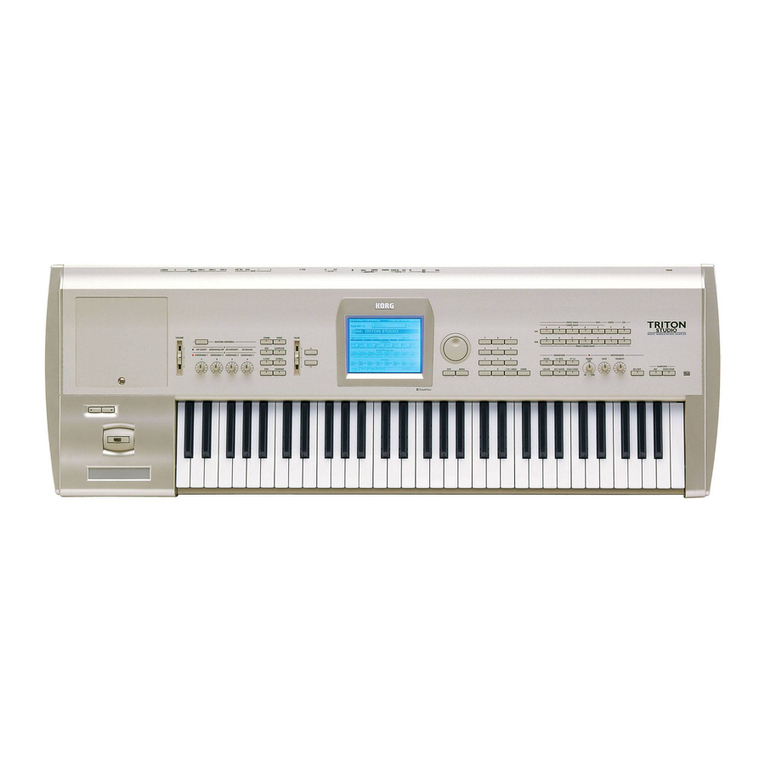
Korg
Korg Triton Studio User manual
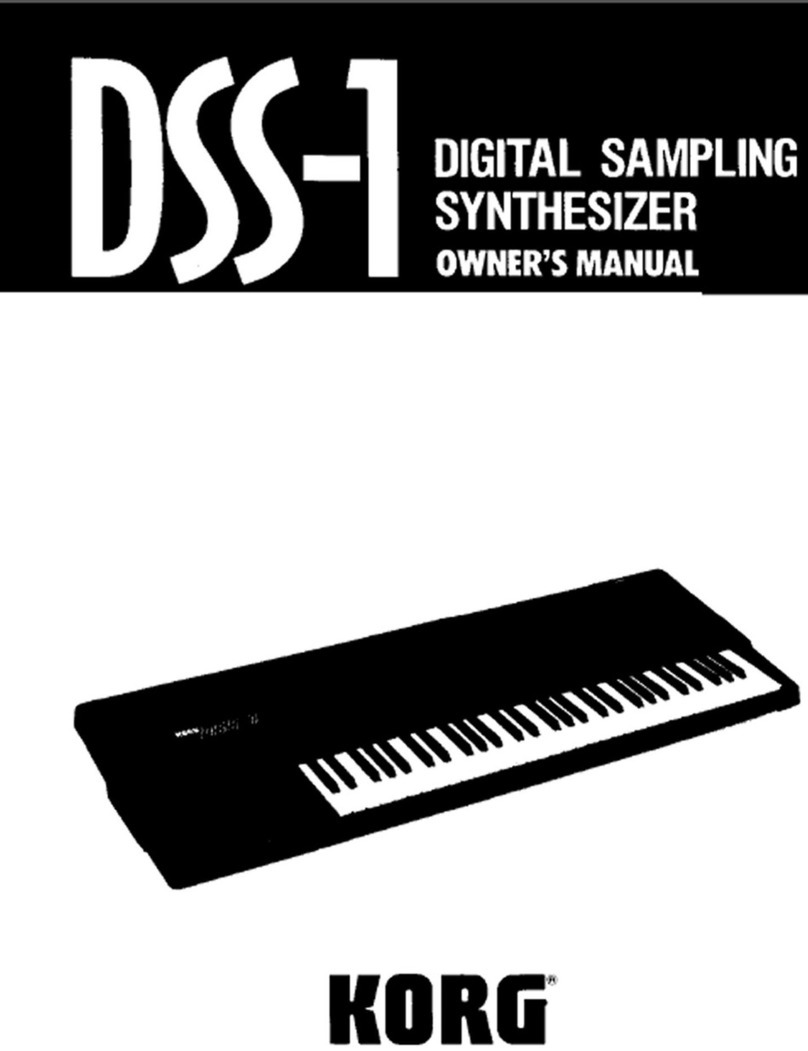
Korg
Korg DSS-1 User manual

Korg
Korg pa2X pro User manual
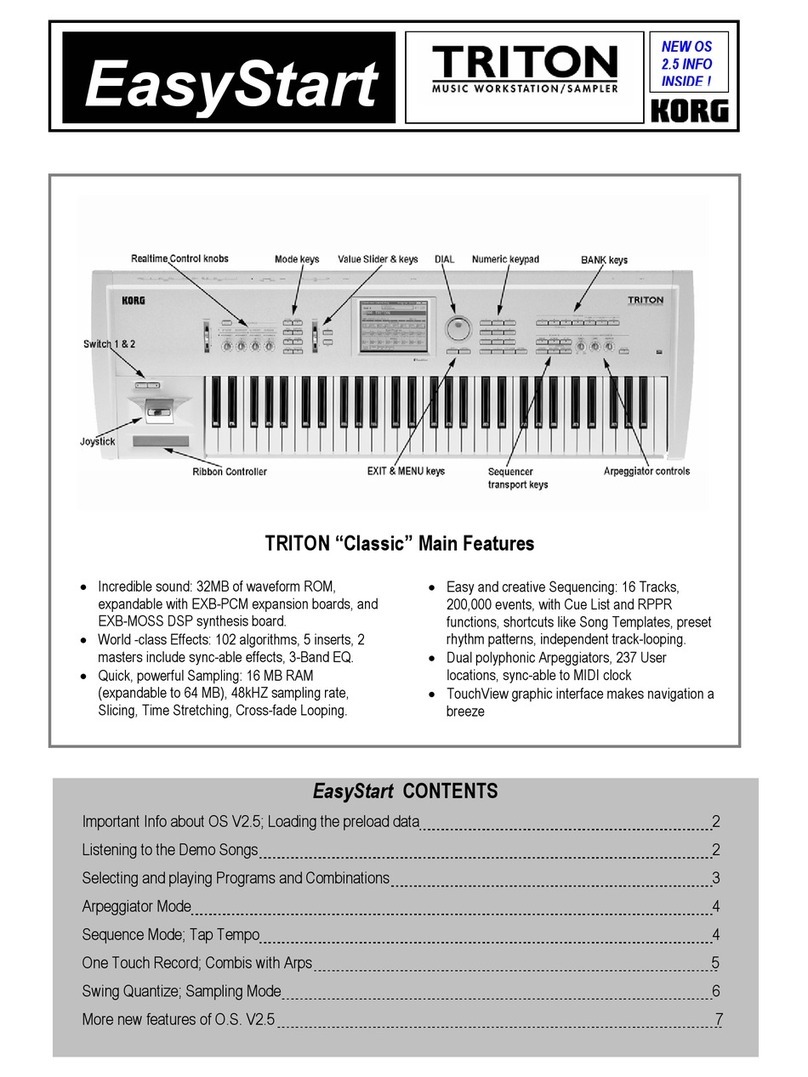
Korg
Korg TRITON Classic Product information sheet

Korg
Korg PA 900 Musikant User manual
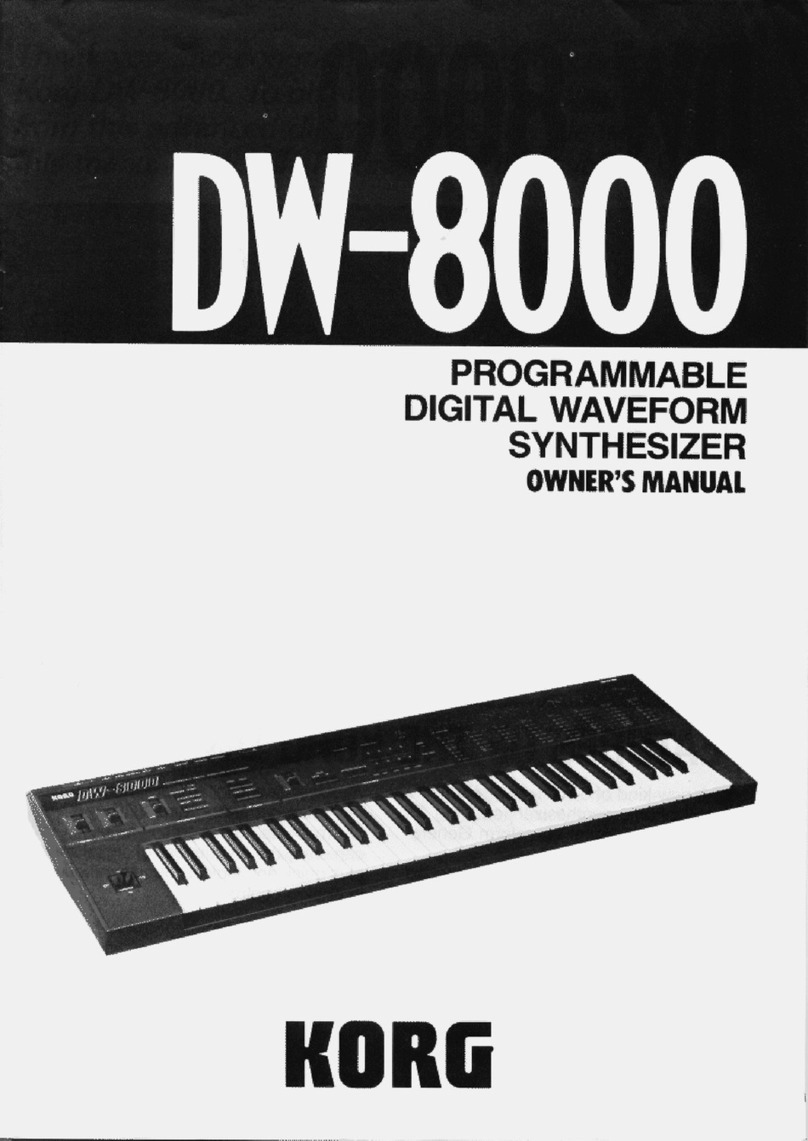
Korg
Korg DW-8000 User manual

Korg
Korg MONOPOLY POLYSIX MS-20 User manual
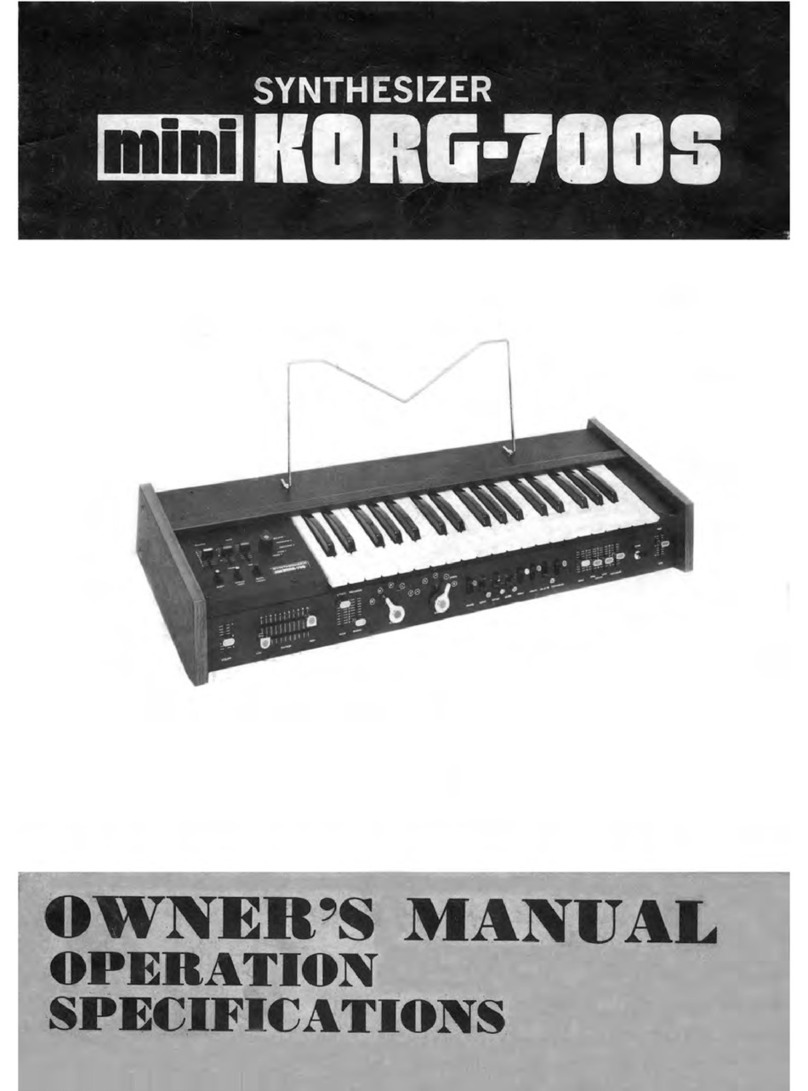
Korg
Korg MiniKorg-700S User manual
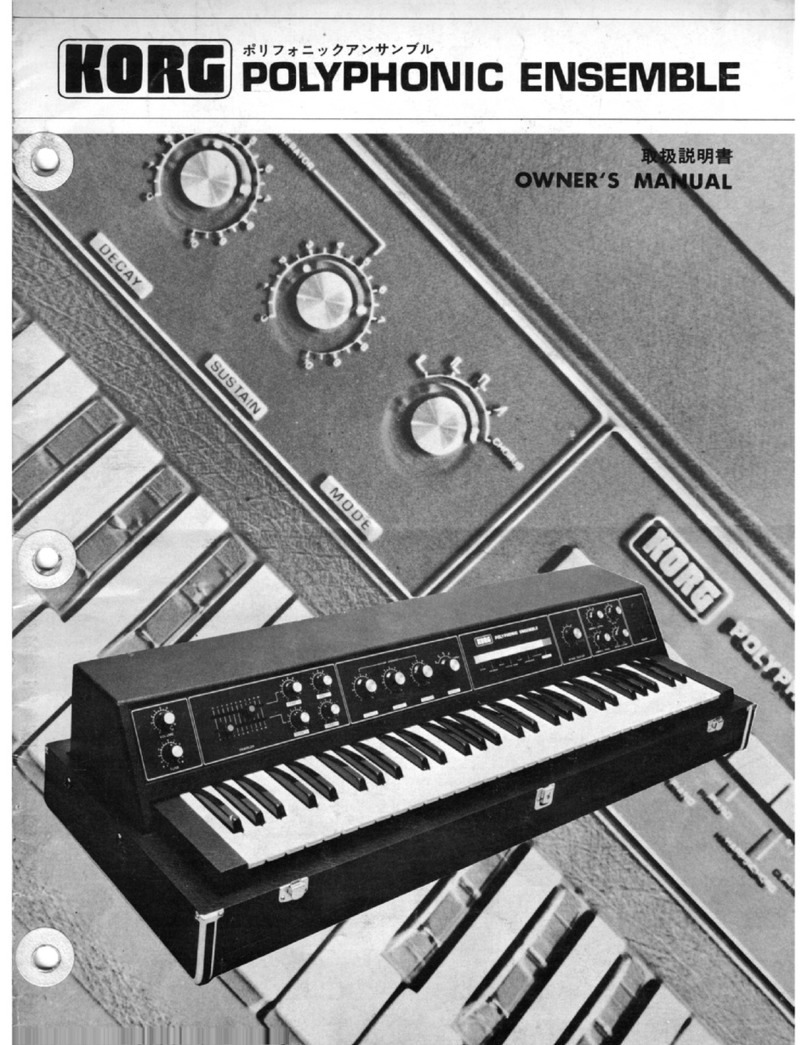
Korg
Korg Polyphonic Ensemble User manual
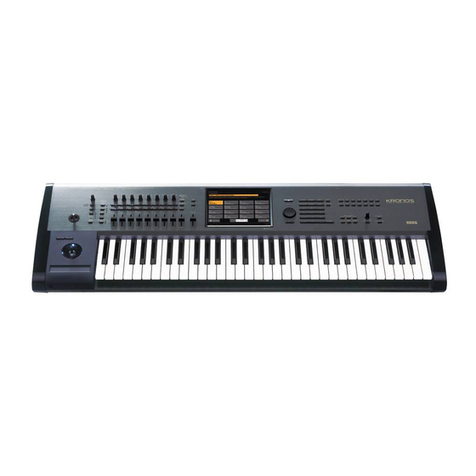
Korg
Korg KRONOS-61 User manual
